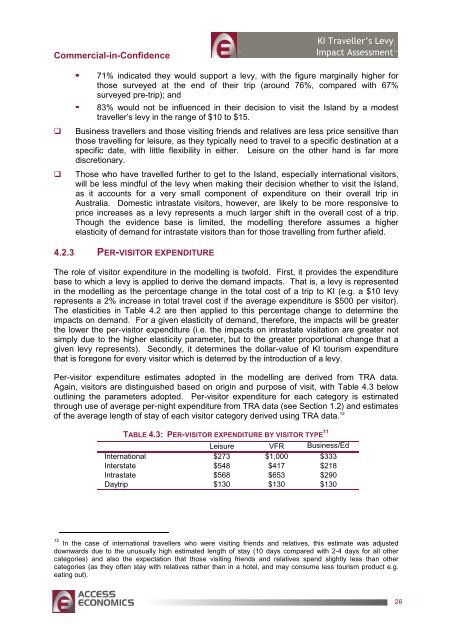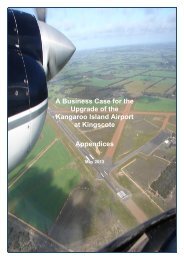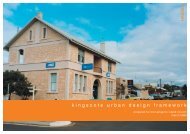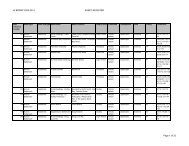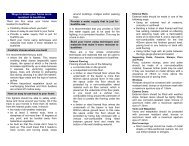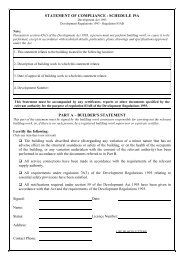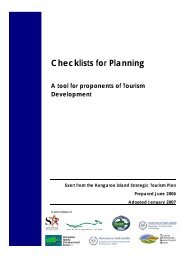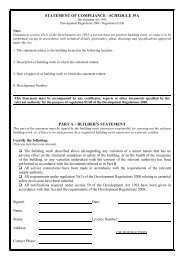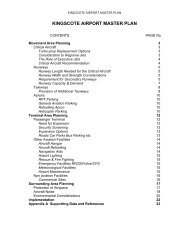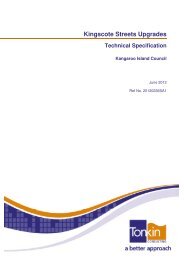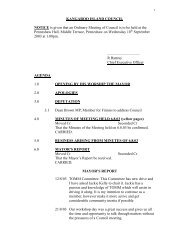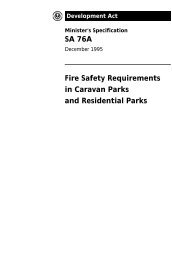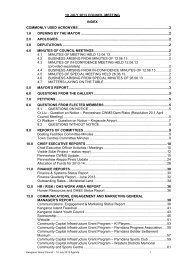KI Traveller's Levy Economic Impact Assessment - Kangaroo Island ...
KI Traveller's Levy Economic Impact Assessment - Kangaroo Island ...
KI Traveller's Levy Economic Impact Assessment - Kangaroo Island ...
You also want an ePaper? Increase the reach of your titles
YUMPU automatically turns print PDFs into web optimized ePapers that Google loves.
Commercial-in-Confidence<br />
<strong>KI</strong> Traveller’s <strong>Levy</strong><br />
<strong>Impact</strong> <strong>Assessment</strong><br />
<br />
<br />
71% indicated they would support a levy, with the figure marginally higher for<br />
those surveyed at the end of their trip (around 76%, compared with 67%<br />
surveyed pre-trip); and<br />
83% would not be influenced in their decision to visit the <strong>Island</strong> by a modest<br />
traveller’s levy in the range of $10 to $15.<br />
<br />
<br />
Business travellers and those visiting friends and relatives are less price sensitive than<br />
those travelling for leisure, as they typically need to travel to a specific destination at a<br />
specific date, with little flexibility in either. Leisure on the other hand is far more<br />
discretionary.<br />
Those who have travelled further to get to the <strong>Island</strong>, especially international visitors,<br />
will be less mindful of the levy when making their decision whether to visit the <strong>Island</strong>,<br />
as it accounts for a very small component of expenditure on their overall trip in<br />
Australia. Domestic intrastate visitors, however, are likely to be more responsive to<br />
price increases as a levy represents a much larger shift in the overall cost of a trip.<br />
Though the evidence base is limited, the modelling therefore assumes a higher<br />
elasticity of demand for intrastate visitors than for those travelling from further afield.<br />
4.2.3 PER-VISITOR EXPENDITURE<br />
The role of visitor expenditure in the modelling is twofold. First, it provides the expenditure<br />
base to which a levy is applied to derive the demand impacts. That is, a levy is represented<br />
in the modelling as the percentage change in the total cost of a trip to <strong>KI</strong> (e.g. a $10 levy<br />
represents a 2% increase in total travel cost if the average expenditure is $500 per visitor).<br />
The elasticities in Table 4.2 are then applied to this percentage change to determine the<br />
impacts on demand. For a given elasticity of demand, therefore, the impacts will be greater<br />
the lower the per-visitor expenditure (i.e. the impacts on intrastate visitation are greater not<br />
simply due to the higher elasticity parameter, but to the greater proportional change that a<br />
given levy represents). Secondly, it determines the dollar-value of <strong>KI</strong> tourism expenditure<br />
that is foregone for every visitor which is deterred by the introduction of a levy.<br />
Per-visitor expenditure estimates adopted in the modelling are derived from TRA data.<br />
Again, visitors are distinguished based on origin and purpose of visit, with Table 4.3 below<br />
outlining the parameters adopted. Per-visitor expenditure for each category is estimated<br />
through use of average per-night expenditure from TRA data (see Section 1.2) and estimates<br />
of the average length of stay of each visitor category derived using TRA data. 12<br />
TABLE 4.3: PER-VISITOR EXPENDITURE BY VISITOR TYPE 11<br />
Leisure VFR Business/Ed<br />
International $273 $1,000 $333<br />
Interstate $548 $417 $218<br />
Intrastate $568 $653 $290<br />
Daytrip $130 $130 $130<br />
12 In the case of international travellers who were visiting friends and relatives, this estimate was adjusted<br />
downwards due to the unusually high estimated length of stay (10 days compared with 2-4 days for all other<br />
categories) and also the expectation that those visiting friends and relatives spend slightly less than other<br />
categories (as they often stay with relatives rather than in a hotel, and may consume less tourism product e.g.<br />
eating out).<br />
26


